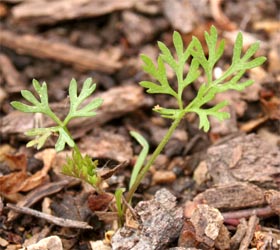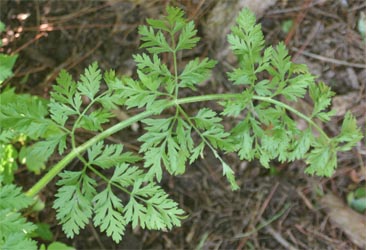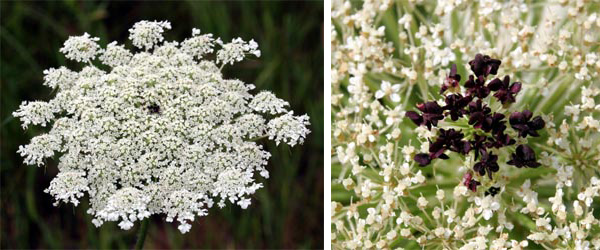
Queen Anne’s lace, Daucus carota (Family Apiaceae), is a common sight in dry fields, roadside ditches and open areas. There are many explanations for the origin of this common name, including the flower’s resemblance to the lace that was fashionable around the time of the British monarch, wife of King James I; because people thought it resembled Queen Anne’s lace headdress; 18th-century English courtiers used the flowers as “living lace;” and supposedly because Queen Anne challenged her ladies-in-waiting to a contest to see who could produce a piece of lace as beautiful as the flower, but none could rival her own efforts.
It is also called wild carrot because this is the European plant that cultivated carrots were developed from. It was brought to North America with the colonists as a medicinal plant and is now naturalized throughout the continent.

Seeds germinate throughout the growing season, producing a small rosette of ferny green leaves. The finely divided alternate leaves are tri-pinnate

(the feather-like leaflets are again divided) and the lower leaves are considerably larger than the upper ones. The plant also produces a firm, yellowish, spindly taproot. Although the root is edible when young (but not tasty like its cultivated relatives), the leaves can cause skin irritation in some people, especially those sensitive to celery or chrysanthemums. There are similar looking plants such as poison hemlock or fool’s parsley (Conium maculatum) and water hemlock (Cicuta maculata) that are poisonous, so care must be taken not to confuse them if collecting wild plants to eat the roots.
This biennial flowers in its second season, then dies. Hollow branched flower stems grow two to four feet tall, and both the stems and leaves are covered with short, coarse hairs. The attractive, airy two- to four-inch “flower” is actually a compound flower. Up to a thousand tiny white flowers are produced in lacy, flat-topped clusters (umbels) with a dark, purplish center. As the seeds ripen, the inflorescence curls inward to form a “bird’s nest” shape and turns a brownish color. A small bristly seed is produced at the end of each flower stalk, and once dry they readily latch onto fur or feathers to be disseminated beyond where the seeds would otherwise fall.




Queen Anne’s Lace is so adaptable that in some habitats it crowds out native species that can’t compete with its vigorous growth. Many people consider Queen Anne’s lace an invasive weed (it is listed as a noxious weed in at least 35 states), but it is used by some native animals for food. It is a host plant for eastern black swallowtail caterpillars and many butterflies and adult bees and beneficial insects utilize the flower nectar. To reduce the spread of this plant, remove the seedheads before they mature.
– Susan Mahr, University of Wisconsin – Madison





 Aster, Symphyotrichum spp.
Aster, Symphyotrichum spp. Fascinating Fasciation
Fascinating Fasciation Alternatives to Lawn: Groundcovers
Alternatives to Lawn: Groundcovers Marigolds
Marigolds


